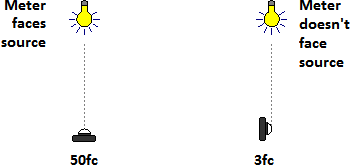Loosely defined, illuminance (E) is the amount of light falling onto an area. Thus, illuminance is a density. The footcandle is the English unit for illuminance and represents the number of lumens (light) incident on an area per square foot of that area. Lux is the metric equivalent of the footcandle and represents the number of lumens incident on an area per square meter of that area. The units used to display illuminance values in Visual may be changed in the Settings Dialog.

Illuminance is a directional quantity, meaning that one must speak not only of the illuminance at a location in the model, but of the illuminance in a particular direction at a location in the model.
One can think of each calculation point as a miniature illuminance meter. The value that each illuminance meter reports depends on the orientation of the meter. For example, a meter at a particular location will have a greater illuminance reading when facing a source than if it faces away from the source.

The most common lighting calculations measure horizontal illuminance on a floor or at desk level for interior applications, or on the ground for exterior applications. This is analogous to placing a light meter on one of these surfaces, facing the meter straight up, and taking a reading.

Other common calculations such as vertical illuminance, TV illuminance and maximum spill illuminance require alternate orientations of the light meters. Visual provides the means to specify calculation points to calculate all of these illuminance types. Indeed, any orientation of the calculation point normals (light meters) may be achieved. For more information on the placing and orientation of Calculation Zones see section Placing Calculation Zones.
